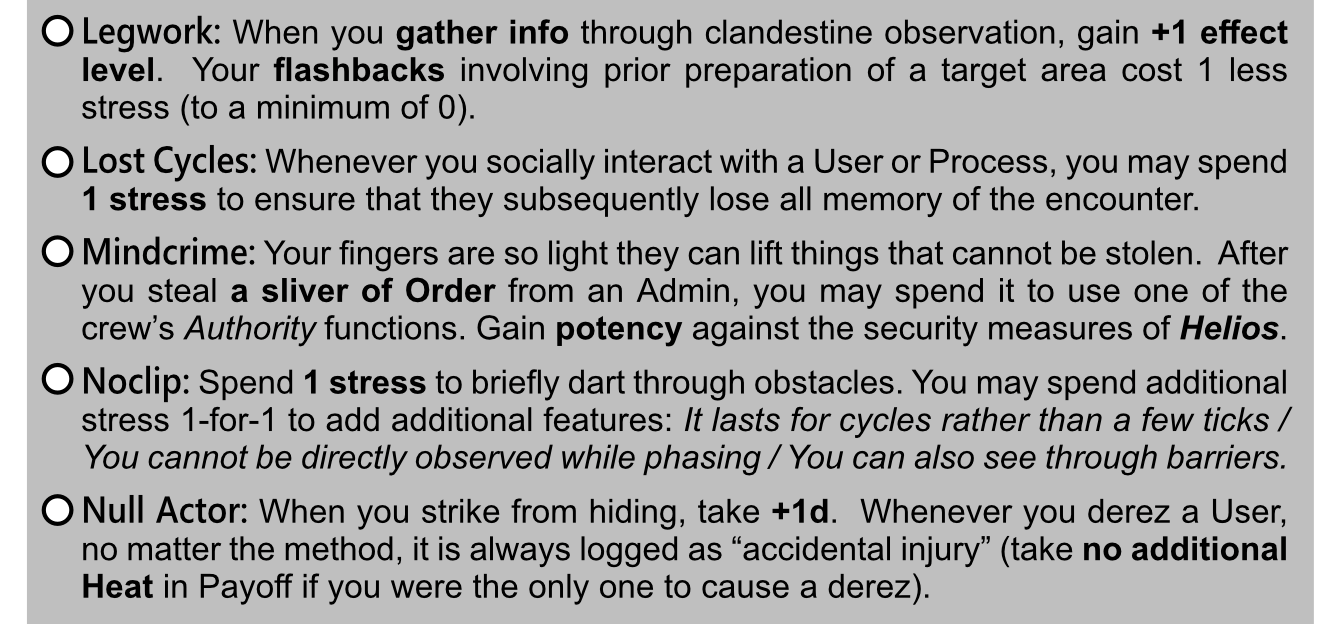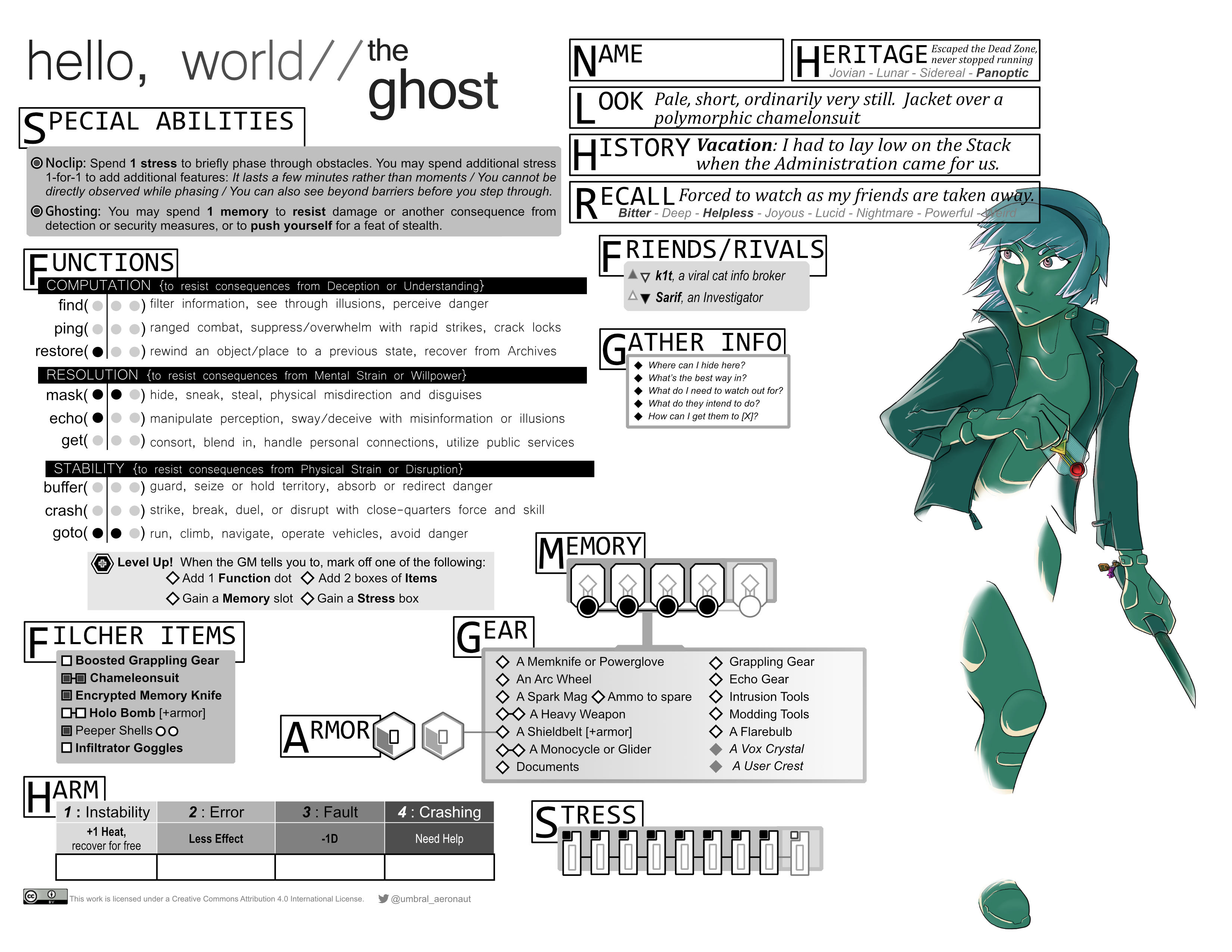The Filcher: Control and Theft In World
Above: one of Hello, World’s pregenerated character sheets using the Filcher playbook as it’s foundation.
Forged in the Dark games are somewhat unique in the action roll conversation that surrounds their primary loop. The goal of the framework is to have the table establish and agree upon some fictional parameters surrounding a die roll prior to throwing our shiny math rocks. The effect in my experience is to simulate a particular kind of thematic representation… mapping a sort of threat space or risk continuum that the crew can move around in. (I realize that many other game systems have differing ways of approaching the stakes question, I should clarify that I’m skimming over such for brevity and because I’m a biased actor who really adores the “Blades in the Dark method”).
The conversation leading to a dice roll might go like this: “Ok, so you’re going to try to convince the Duke that you belong on this floor.” That’s where a lot of roleplaying systems end the discussion, segueing directly into a dice roll. Forged in the Dark demands a little extra though. “Ok, so you’re going to try...” might lead the GM into the following line: “Seems Desperate to me, and you’ll have Limited effect.” Or maybe instead the GM will say “Seems Controlled to me, and you’ll have Great effect!” Why would the GM say one thing over the other? Are you dressed like you belong here? Does the Duke know your face? Were you seen downstairs in the party before now? Is the Duke intended to be a perceptive adversary in this moment, or are they relaxed and slightly drunk? Are guards on the scene, are you being questioned at gun-point? A whole host of possible factors can be communicated at the table through setting those dials and pre-establishing the stakes of the dice roll.
The continuum of Position and Effect (ie. how dangerous the thing being attempted is, what a success looks like and some possible ways failure or complication might be invoked) is an entire ecosystem in FitD games, one that the table is encouraged to manipulate for advantage (mechanical hooks, like taking Desperate actions for the XP bonus) or to tell the particular story of your game session (the rising and falling tension of the conflict in a score). I was turning to this thinking by something the excellent Avery Alder said about Playbook design (link to a twitter thread), in which she suggested that designers should identify the economy or 'engine' of systems in your game and what each individual playbook wants to do to overlay or manipulate that economy. At the time I was designing Playbooks for Hello, World and struggling with a mechanical theme for my Lurk analogue, the Filcher.
In response to Avery’s challenge, I designed the following special ability for the Filcher, which doesn’t look like much and might easily be overlooked. Unlike a lot of the Special Abilities I tend to prefer, it doesn’t strongly suggest a thematic twist to your character or open up a new fictional permission space. It doesn’t make a lot of sense to take as the first SA of the playbook, or indeed even the second. It’s more of a capstone or ‘prestige’ ability, and yet I think it ties together the themes of the Filcher perfectly.

The thing about Steady Hands is that it latches onto the particular fiction/mechanics interface that exists in Forged in the Dark and how this playbook wants to approach it. The thief/rogue archetype is a person who benefits greatly from Controlled positions: they prefer to be hidden, ambushing, overlooked, or disguised. They thrive outside the fray, choosing their moment to act with precision.
Encoding mechanical bonuses in the Controlled action space needs to be done with a light touch (pardon the pun). Controlled positions are extremely good for the player already, and pushing on the scale too hard with a Special Ability could make a Filcher unwilling to act in Risky or Desperate circumstances, warping their relationship to the central risk slider too much. In this case, the payoff is small and not necessarily game-changing, and the trigger is rolling a 6 which is never any kind of guarantee using the dice pool sizes FitD goes for.
On the flip side of that coin though, Steady Hands is potentially amazing since it offers the rare prize of free Stress Healing in the middle of a Score. What I like most is that it prompts the artful dodger to change their behavior in the context of Controlled actions (normally a space to relax and take a ‘freebie’ low-consequence action roll) and instead STACK their dice roll. Beg your friends for Assistance! Push yourself! Take the Bargain! If you can just fish out a 6, you’ll be getting PAID BACK! This plays into the mindset of a high-strung perfectionist, aggressively burning resources and stress to stay one step ahead of the opposition. Can you finish the score and make it out without ever blowing your cover and getting noticed? The design of the Filcher playbook begs the question.
With this linchpin in place, I discovered that every single other Special Ability for the Filcher took on new significance. Lost Cycles (whose core concept I stole from the excellent Forgotten in fellow FitD hack A Nocturne) lets a Filcher mesmerize an NPC they’ve interacted with, keeping their cover from being blown. The bonus die from Null Actor helps a backstabbing ambusher 'fish' for the 6 when they strike from hiding, hopefully preventing a circumstance where the alarm is raised and the situation degrades to Risky. Legwork prompts the player to obsessively gather information and rely on the Flashback mechanic, pushing the narrative at the table towards prepared scenarios where the Filcher already has the upper hand. Mindcrime pushes in the opposite direction by daring the player to break cover and steal from the terrifying alien Administrators or crack security measures in the unforgiving high-tier landscape of Helios, taking the Filcher away from their comfort zone and suggesting risky or even desperate narratives. None of them directly reference Controlled positions, because they don’t need to. The underlying narrative engine of Forged in the Dark takes care of the rest.

The Filcher’s core functions are Mask and Goto. As discussed before with the Breaker’s relationship to the Buffer function, which has tactical control of space as part of it’s portfolio, I really like action lists that help emphasize physical positioning. While crafting the 9 functions of World I wanted to twist the paradigm offered by Blades a bit, and because I was shrinking my list it was necessary to refocus some and subsume others (this is also partly what led to the complete vanishing of the Command verb as I realized intimidation and uneven-power-dynamic social interactions weren’t desired as part of the standard 'verb suite' of World).
World is a physics simulation, and the physics are similar but not exactly like what we’re used to (ie. this is your excuse to narrate improbable anime action scenes). In practice, I knew that I wanted control over bodies in space to be key to World, with Users running or even dueling on vertical surfaces, leaping across chasms, vanishing through walls (see: Noclip) or smashing through them (the Breaker and Roller both have this). Split-merging the Prowl and Finesse actions into Mask and Goto was one of the ways I chose to break this down. My goal was to see an entire action dedicated to physical movement, dodging harm, scaling walls, navigation, arriving in unexpected spaces (Goto). And then another action that absorbed the ‘physical misdirection’ or stealth aspects, to include palming objects unnoticed, stealthily moving through an environment, and disguising oneself as a dark shape on the wall or an uninteresting Process in the room (Mask). In this way the Lurk is still very much present in the Filcher’s DNA, but the choice of where to plant your action dots leads into two interesting pathways rather than an obvious primary path (stealth PLUS movement anywhere PLUS ambushing with close violence PLUS...) and a clearly secondary path (the gaggle of miscellaneous actions covered by Finesse).

One interesting side-effect of following the changes I wanted at the Poetry layer (ie. using vaguely-coding related terminology and chasing a slightly dream-like computer simulation theme) is that the action for lock-cracking migrated over to Ping, further differentiating the suite of tasks that might be needed for successful intrusion. Because World is a physics simulation occurring within some kind of computer, I knew that there would be no ‘hacking’ sublayer… everything is already a metaphor, why muddy the water further? (I also intensely dislike sub-systems that separate the spheres of influence PCs wield too sharply, like the traditional “decker” from cyberpunk-style games). More on that later when we discuss the Restore function (basically World’s magic) and just how awesome an innovation the Ghost Field is for Blades.
Especially if your FitD hack is going to narrow down the action list as mine does, you want to think very critically about what kind of story the language of the Action rolls you have chosen seek to tell. Are all of the verbs intended to get the same amount of use? Should they? Do you need 12 verbs to tell your kind of story? What about 9? What about 15? By working the verbal language of the stories that Hello, World wants to tell out from first principles, and setting a tighter restriction on myself than I thought I needed, I was able to learn interesting new things about what World could be and also what it wasn’t.
Get Hello, World
Hello, World
Memory & Loss in a crumbling utopia
| Status | In development |
| Category | Physical game |
| Author | Charles Simon |
| Genre | Role Playing |
| Tags | Anime, blades-in-the-dark, Cyberpunk, Forged in the Dark, Sci-fi, Tabletop, Tabletop role-playing game, vaporwave |
More posts
- Version 7.9 content push: crew creation, score prompts, factions & districts!Mar 03, 2022
- World version 0.78 _ Playbook adjustments & Handout changesNov 13, 2020
- World version 0.75_huge update!Sep 18, 2020
- Hello, World super update! New GM Guide, new Playbooks, new Setting notes, new...Dec 04, 2019
- The Roller: Momentum and Leadership in WorldNov 27, 2019
- The Breaker: Force and Hurt in WorldNov 19, 2019
- Playbook update: the CapacitorNov 05, 2019

Leave a comment
Log in with itch.io to leave a comment.